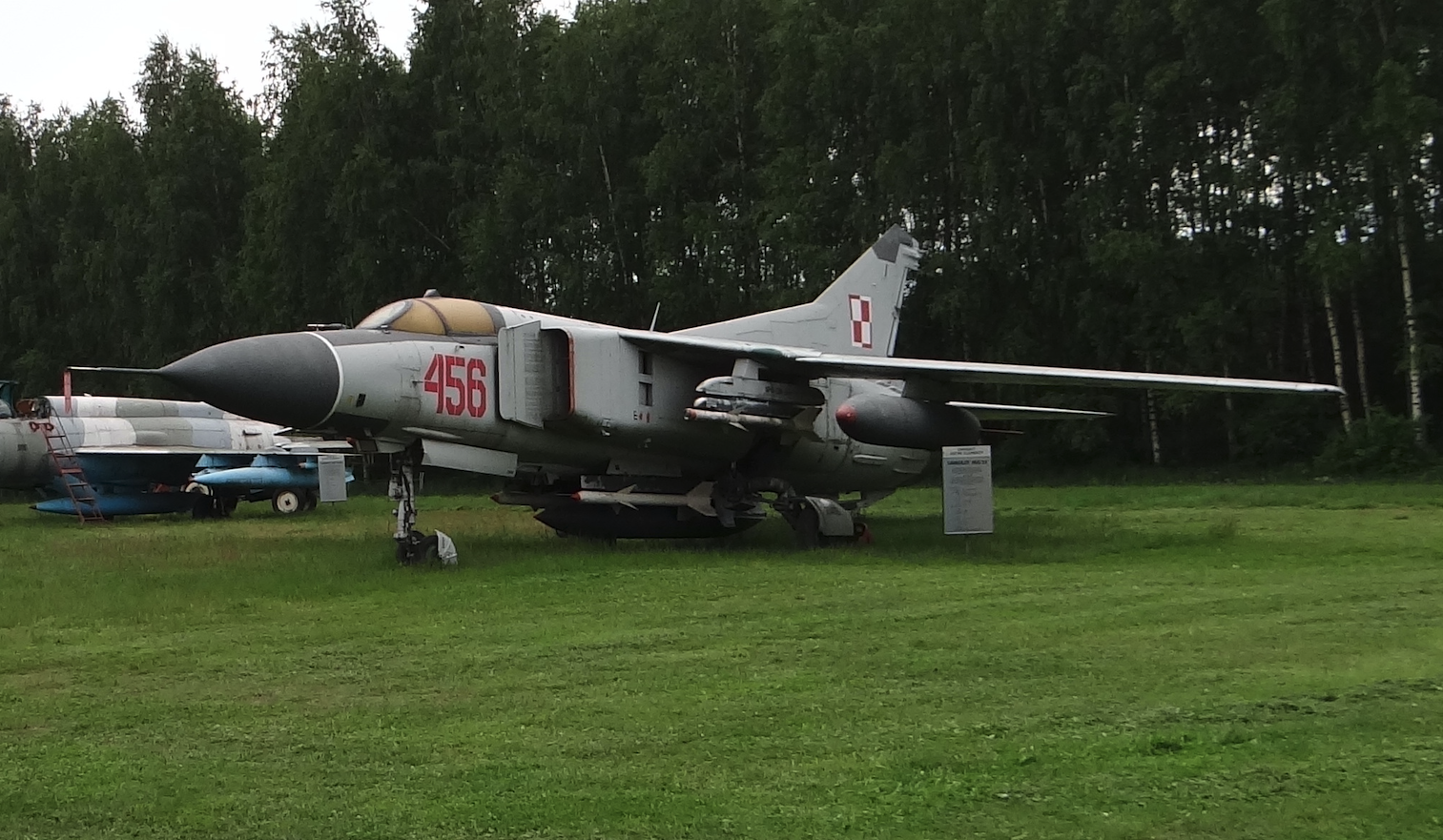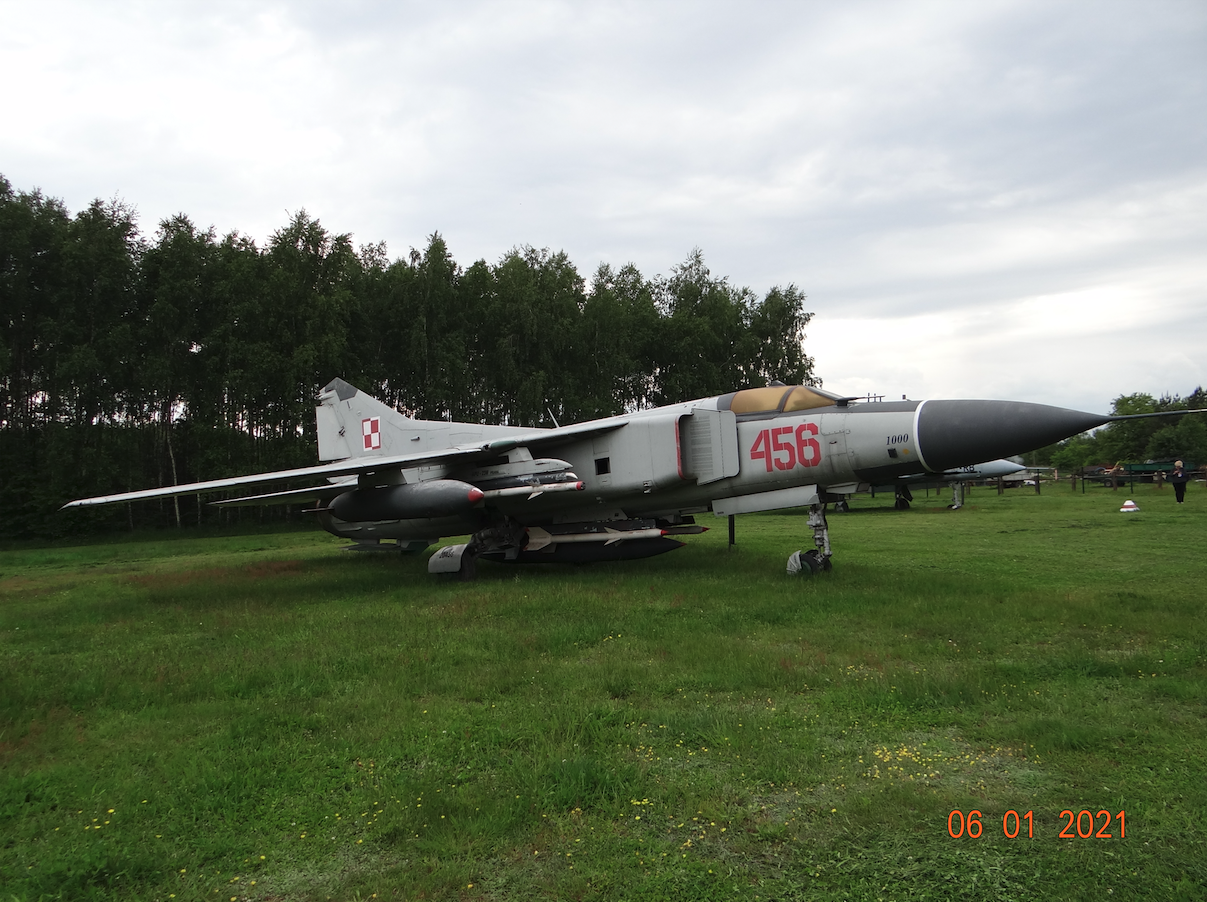Napoleon 2022-11-20
Mikojan and Guriewicz MiG-23 MF nb 456.
255 Section 1979-06-04. Poland.
MiG-23 in Poland. 1979.
Our politicians and the military encountered the MiG-23 aircraft for the first time when they were looking for a successor to the Il-28 bomber aircraft. The last 6 bombers were decommissioned in 1979, but for the entire decade they were no longer of any combat value. CCCP offered us MiG-23 BN or Su-20 aircraft. Both aircraft with variable wing geometry. According to Polish specialists, none of the offered planes met our requirements, but there was no other alternative. The choice fell on the Su-20, as a cheaper machine and similar to the Su-7 aircraft used by us so far.
The search for a new plane for WOPK was similarly hard. Our Eastern partner (then it should be said – brotherly country) offered us the MiG-23 MS aircraft. This offer did not satisfy Poland very much. These were aircraft with armament from MiG-21 bis aircraft. They had no opportunity to attack on the encounter course. In addition, problems with the operation of these machines effectively discouraged the Polish side from this investment. Offering the MiG-23 M version for export was constantly postponed.
The MiG-23 MS aircraft was retrofitted with newer avionics and a large number of design flaws were removed. The resulting version was called the MiG-23 MF and was offered to the Polish side. This time, in May 1978, the proposal was positively reviewed and accepted.
At the same time, a decision was made to train the first group of pilots and technicians for a new type of fighter. The first of the three air regiments planned to be rearmed was the 28th PLM stationed in Słupsk. However, before a group of Polish officers was selected for training in CCCP, the staff of the unit from Słupsk, using the invitation of the Soviet 871st PLM, which was stationed in Poland in Bagicz near Kołobrzeg, got acquainted with the aircraft and its capabilities. Soviet pilots presented the MiG-23 M aircraft in flight, and the technicians had the opportunity to familiarize themselves with the airframe and its operation.
Opinions of Polish officers were different. On the one hand, there was talk of a high failure rate of machines and complicated operation. However, positive opinions prevailed. A lot of attention was paid to the variable geometry of the wings, which so far could only be seen in Powidz, where in 1976, the conversion to the Su-20 fighter-bomber was completed. Good take-off and landing parameters, high ceiling and high maximum speed of the MiG-23 M aircraft filled with optimism.
On January 29, 1979, a group of 13 pilots from the 28th PLM and technicians, under the command of Lieutenant Colonel Janusz Dorożyński, went to Ługawoje in CCCP for a three-month training. The following pilots participated in this training: Lt. Col. drink Janusz Dorożyński, Lt. Col. drink Waldemar Piegza, Major Pil. Bogdan Sokołowski, Major pil. Mieczyslaw Walentynowicz, Capt. drink Andrzej Jasinski, Capt. drink Tadeusz Potoczała, Capt. drink Zbigniew Rozalski, Capt. drink Stanisław Szafruga, see pil. Jerzy Bekus, see pil. Ryszard Drzymała, see pil. Marian Krzeminski, see pil. Janusz Rybicki, see pil. Czesław Zabiełło (did not complete the training).
The pilots underwent a two-month theoretical training completed with an exam, after which they sat at the controls of the Soviet MiG-23 M/MS/MF/UB. The first flights showed good flight characteristics. Fast acceleration of the machine has been confirmed. The engine revved up quickly and willingly. The plane was easy to fly. The performance and equipment of the MiG-23 were nothing like the fighters used so far in Poland. We mean the MiG-21 up to and including the MF version. In the assumptions, the MiG-23 was to completely displace the MiG-21 fighters from the front line.
On April 28, 1979, after passing the final exams, the entire staff returned to Poland. At that time, the airport in Słupsk was closed, as it underwent a significant modernization. RWY and taxiways have been strengthened. All the unit’s flying equipment was transferred to Zegrze Pomorski, where training was continued. Also in 1979, the transfer of some of the previously operated MiG-21 MF and MiG-21 UM aircraft to other regiments began.
Unfortunately, despite the efforts, the modernization in Słupsk was not completed until the arrival of the first MiG-23 machines. Therefore, it was decided that the planes would be accepted at the airport in Mińsk Mazowiecki.
A month before the date of delivery of the first batch of MiG-23 aircraft, a group of pilots and technicians from the 28th PLM went to Mińsk Mazowiecki to receive aircraft from the Soviet side.
We received the first MiG-23 MF / UB aircraft on June 4, 1979, in the number of 11 copies: MiG-23 MF nb 120, 121, 122, 139, 140, 141, 145, 146, 147, 9 pieces in total, MiG- 23 UB nb 845, 846 together 2 pieces. Factory pilots flew in planes. There were Russian identification marks (red stars) on the planes, which were quickly washed off after landing. Technical acceptance took place and an official acceptance protocol of the machines was signed. Seven days later, on June 11, 1979, the first flights began under the supervision of 12 Russian engineers. The first Polish pilots who sat at the controls of the MiG-23 UB side number 845 were the commander of the 28th PLM, Lt. Col. pilot Janusz Dorożyński and major pilot Bogdan Sokołowski.
As a side note, it should be noted that when the first MiG-23s were brought to Poland, they had been in service with the CCCP for 9 years, and for several years they were in stock in African countries such as Sudan, Libya, and in Europe, East Germany and Czechoslovakia.
In the 28th PLM, the MiG-23 aircraft replaced the previously used MiG-21 MF, Lim-5, SBLim-1/2 aircraft. Thus, the second structure with variable wing geometry began to be used in Poland. It should be reminded here that at that time the variable geometry of the wings was a future solution, considered the most appropriate direction.
On June 25, 1979, three more MiG-23 MF nb 148, 149, 150 aircraft arrived in Poland.
At the end of 1979, the renovation of the airport in Słupsk was completed. Therefore, on January 4-7, 1980, the 14 MiG-23 MF / UB aircraft were transferred from Mińsk Mazowiecki to Słupsk to Redzikowo. On January 14, 1980, training began at the regiment’s home airfield. But already on April 30, 1980, in accordance with the command of the regiment commander, the planes were transferred to the alternate airfield in Pieniężnica, where he stayed until July 18, 1980. It should be added that at that time the MiG-23 aircraft were in stock of the 1st Squadron, and the 2nd Squadron was still using the MiG-21 MF aircraft.
The first flights of Polish MiG-23s for combat tasks took place in June 1980, during the Granit-80 exercises. Pilots for the first time, on a large scale, intercepted air targets and took part in organized air attack groups. They also performed escort functions, covering groups attacking ground targets. Another occasion was a two-stage exercise code-named Argon-80. Pilots from the 28th PLM at the Ustka sea range with the help of CRP guided missiles The R-3 S engaged air targets imitated by light bombs dropped from a higher altitude by other aircraft. The second part of the maneuvers took place on the premises of the CCCP, at the training ground in Astrakhan. Polish pilots were transported on board the Polish Il-18 aircraft. On site, they used Soviet MiG-23 M/MS/MF aircraft of the local regiment. It should be noted that individual machines differed significantly in equipment, layout of switchboards, and even the lack of some instruments. Polish pilots had the opportunity to launch CRP missiles. for flying targets La-17, popularly known as Łaszeńki. Similar exercises were also held in 1982, 1984 and 1985.
From October 13, 1980, the 28th Regiment reached combat readiness and began permanent combat duty.
Even before the delivery of the next batch of aircraft to the 28th PLM, on May 25, 1981, the first MiG-23 MF nb 140 aircraft, piloted by Captain Ryszard Drzymała, was lost as a result of a failure. The plane was approaching from the west side of the runway. At the last moment, he released the landing gear, which unfortunately did not lock in the locks. The landing gear folded and broke on touchdown. The pilot released the drag parachute. The plane slowed to a halt, scraping its belly across the runway. At the end of the landing run, he leaned against the right wing and slid off the concrete onto the grass. The pilot was not seriously injured. However, the damage to the machine turned out to be very serious and its renovation was finally abandoned. On April 26, 1985, this aircraft was handed over to COSSTWL in Oleśnica. Over time, the aircraft began to be marked nb 40, and years later, after the dissolution of the center, the aircraft was transferred to the Radom-Sadków airport as a monument. In 2012, the aircraft was donated to the Air Force Museum in Dęblin.
On January 29, 1981, MiG-23 UB nb 850 flew to Słupsk. On September 2, 1981, MiG-23 nb 455, 456, 457, 458, 459 aircraft arrived, and on September 25, 1981, MiG- 23 nb 460, 461, 001, 005, 007, 010, 012. On October 19, 1981, two MiG-23 UB aircraft were delivered.
The last aircraft were delivered in 1982. On June 26, 1982, the last sixth MiG-23 UB machine was delivered. On August 25, 1982, MiG-23 MF nb 062, 065, 101, 102, 105 were delivered, and on September 21, 1982, MiG-23 MF nb 021, 050,110,115, 117, 152, 153 aircraft. In Poland, MiG-23 aircraft were only used by the 28th PLM Słupsk. hunting regiments; 26. PLM Zegrze Pomorskie and 34. PLM Babie Doły received MiG-21 bis aircraft.
Deliveries of a total of 36 examples were completed in 1982. They served until 2000.
MiG-23 MF nb 456 nr 390220456.
MiG-23 MF nb 456 No. 390220456 was delivered to Poland on September 2, 1981, in the fourth batch. He served only in the 28th PLM Słupsk. It was taken out of service in 1998. After some time (2018) it went to the 303 Squadron museum in Napoleon.
Written by Karol Placha Hetman





